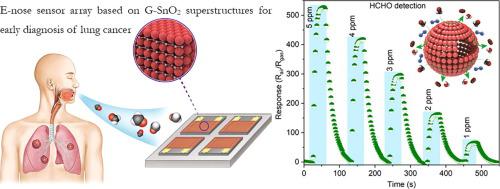Chemical Engineering Journal ( IF 15.1 ) Pub Date : 2022-06-22 , DOI: 10.1016/j.cej.2022.137736 Arunkumar Shanmugasundaram , Sunkara V Manorama , Dong-Su Kim , Yun-Jin Jeong , Dong Weon Lee

|
Detecting specific biomarkers in human breath is essential for diagnosing various diseases, including lung cancer, asthma, and halitosis. Formaldehyde (HCHO) is a vital biomarker found in the exhaled breath of lung cancer patients. The threshold concentration of HCHO in lung cancer patients is 83 parts per billion (ppb), as opposed to 48 ppb in healthy people. Over the years, several semiconductor metal oxide (SMO)-based gas sensors have been proposed to detect HCHO. However, the detection of HCHO at ppb levels in complex environments at relatively low operating temperatures remains challenging. In this paper, we have discussed a high-performance HCHO sensor that employs three-dimensional (3D) reduced graphene oxide-incorporated SnO2 nanosphere superstructural architectures (rGO-SnO2-SS). The proposed sensor exhibited excellent sensitivity (as low as 100 ppb with a detection limit of 10 ppb at 125 °C). The rGO-SnO2-SS sensor exhibited a 4.15-fold, 3.59-fold, 1.44-fold and 2.58-fold increase in sensing response compared to the bare SnO2-nanospheres (SnO2-NS), rGO-SnO2 tiny superstructures (rGO-SnO2-TSS), rGO-SnO2 partial superstructures (rGO-SnO2-PSS) and rGO-SnO2 nanocomposite (rGO-SnO2-NC) sensors. An evaluation of the ability of the proposed sensor to diagnose lung cancer by detecting HCHO in exhaled breath revealed that in the rGO-SnO2-SS hybrid nanocomposite-based e-nose sensor arrays, the signals from healthy and simulated lung cancer breaths did not overlap, i.e., healthy, and unhealthy breaths, could be differentiated with pinpoint accuracy. Thus, the proposed sensor based on rGO-SnO2-SS can be effectively used to easily screen lung cancer patients and monitor indoor HCHO concentrations.
中文翻译:

走向护理点慢性病管理:使用基于 rGO/SnO2 超结构的电子鼻传感器检测呼出气中的生物标志物
检测人类呼吸中的特定生物标志物对于诊断各种疾病至关重要,包括肺癌、哮喘和口臭。甲醛 (HCHO) 是一种在肺癌患者呼出气中发现的重要生物标志物。肺癌患者中 HCHO 的阈值浓度为十亿分之 83 (ppb),而健康人中则为 48 ppb。多年来,已经提出了几种基于半导体金属氧化物 (SMO) 的气体传感器来检测 HCHO。然而,在操作温度相对较低的复杂环境中检测 ppb 水平的 HCHO 仍然具有挑战性。在本文中,我们讨论了一种高性能 HCHO 传感器,该传感器采用三维 (3D) 还原氧化石墨烯并入 SnO 2纳米球超微结构结构 (rGO-SnO 2-SS)。所提出的传感器表现出出色的灵敏度(低至 100 ppb,在 125 °C 下的检测限为 10 ppb)。与裸 SnO 2 -纳米球 (SnO 2 -NS)、rGO-SnO 2微型超结构相比,rGO -SnO 2 -SS 传感器的传感响应提高了 4.15 倍、3.59 倍、1.44 倍和 2.58 倍(rGO-SnO 2 -TSS)、rGO-SnO 2部分超结构 (rGO-SnO 2 -PSS) 和 rGO-SnO 2纳米复合材料 (rGO-SnO 2 -NC) 传感器。对所提出的传感器通过检测呼出气中的 HCHO 来诊断肺癌的能力的评估表明,在 rGO-SnO 2-SS 基于混合纳米复合材料的电子鼻传感器阵列,来自健康和模拟肺癌呼吸的信号不重叠,即健康和不健康的呼吸,可以精确地区分。因此,所提出的基于 rGO-SnO 2 -SS 的传感器可以有效地用于轻松筛查肺癌患者和监测室内 HCHO 浓度。


























 京公网安备 11010802027423号
京公网安备 11010802027423号